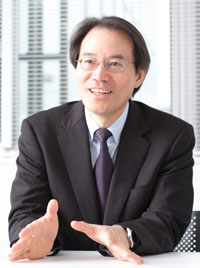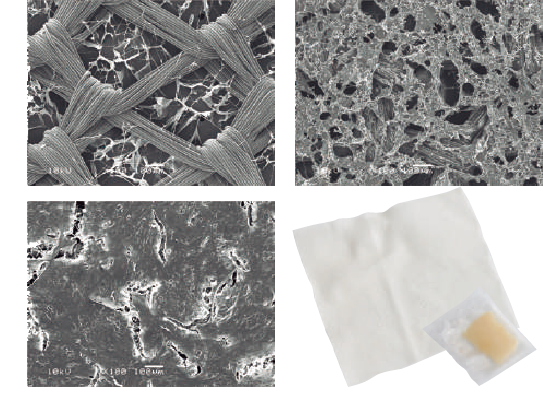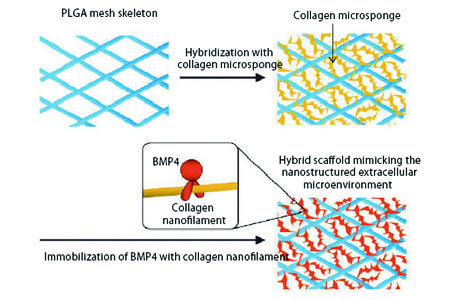- Home
- > Outreach
- > Publications
- > CONVERGENCE
- > ASKING THE RESEARCHER
 ASKING THE RESEARCHER
ASKING THE RESEARCHER
Guoping Chen MANA Principal Investigator Coordinator of Nano-Life Field, Unit Director of Tissue Regeneration Materials Unit and Biomaterials Unit
Nano-Life Field, MANA PI Coordinator, Unit Director of Tissue Regeneration Materials Unit and Biomaterials Unit
Regenerative medicine is a cutting-edge field of medicine which is expected to be realized in the near future. However, many points in connection with the mechanism of tissue and organ regeneration remain to be elucidated. For example, what is the path to regeneration of tissues and organs by appropriate differentiation of stem cells ? MANA’s Dr. Guoping Chen is taking on the challenge posed by these questions by an approach based on nanomaterials.
Why is regenerative medicine needed?

What kind of medical treatment is conceivable in cases where a patient has lost part of his or her body tissue or organs, or has lost physiological functions due to an illness or accident?
Conventioanl treatment takes the form of an organ transplant or an artificial organ. However, in organ transplantation, there is a chronic shortage of donor organs, and even assuming the necessary organ is available, the medical risks associated with organ transplants are hardly negligible. For example, immunorejection and medical complications caused by the use of immunosuppressant drugs are potential problems. On the other hand, artificial organs such as artificial joints can partially replace lost functions, but problems such as the maintenance necessary in long-term use still remain. Regenerative medicine, which has attracted much interest in recent years, was proposed in order to overcome these problems.
Regenerative medicine asks whether it might be possible to create new organs and tissue from cells. Although originally regarded as a nonsensical idea, regenerative medicine has been an area of active
research gradually since the 1970s, and has now advanced to the stage of clinical trials in some cases.
Dr. Guoping Chen says that he also began research on regenerative medicine based on a desire to help patients with critical conditions.“When I came to Japan in 1993, the Organ Transplantation Law had
still not been established in this country, so we had to ask what treatment was possible for patients with heart disease, kidney disease and other very serious conditions. At the time, the concept of regenerative medicine and tissue engineering had appeared in the United States, and the development of therapeutic methods which did not depend on donors began. I was extremely interested in this.”
Conventioanl treatment takes the form of an organ transplant or an artificial organ. However, in organ transplantation, there is a chronic shortage of donor organs, and even assuming the necessary organ is available, the medical risks associated with organ transplants are hardly negligible. For example, immunorejection and medical complications caused by the use of immunosuppressant drugs are potential problems. On the other hand, artificial organs such as artificial joints can partially replace lost functions, but problems such as the maintenance necessary in long-term use still remain. Regenerative medicine, which has attracted much interest in recent years, was proposed in order to overcome these problems.
Regenerative medicine asks whether it might be possible to create new organs and tissue from cells. Although originally regarded as a nonsensical idea, regenerative medicine has been an area of active
research gradually since the 1970s, and has now advanced to the stage of clinical trials in some cases.
Dr. Guoping Chen says that he also began research on regenerative medicine based on a desire to help patients with critical conditions.“When I came to Japan in 1993, the Organ Transplantation Law had
still not been established in this country, so we had to ask what treatment was possible for patients with heart disease, kidney disease and other very serious conditions. At the time, the concept of regenerative medicine and tissue engineering had appeared in the United States, and the development of therapeutic methods which did not depend on donors began. I was extremely interested in this.”
The nano-sized microenvironment is deeply related to cell differentiation.
As Dr. Chen explains, “Three elements are necessary in regenerative medicine, namely, cells, cell growth factors and scaffolds. First, the cells used in regenerative medicine include stem cells such as embryonic stem cells (ES cells), induced pluripotent stem cells (iPS cells) and somatic stem cells, and somatic cells of tissues which have differentiated from stem cells. The cell growth factors control and promote proliferation and differentiation of these cells to make it possible to induce regeneration of large tissues from a small number of cells. The scaffolds are the materials where cells adhere, and also play the role of securing the space for regeneration. It is important to use these three elements individually or in appropriate combinations.”
The main type of cells which Dr. Chen uses is mesenchymal stem cells (MSC). These stem cells, which are taken from bone marrow, etc., are cultured and used clinically. Dr. Chen notes that the most difficult problem in using stem cells is control of differentiation. “The most difficult point is inducing differentiation of stem cells. The problem is how to guide the stem cells to be committed in the direction of the target tissue cell. Ideally, we would know the factor involved, but that’s also the most difficult issue. That’s a problem that researchers around the world are studying.”
As a distinctive feature of Dr. Chen’s research, he says that he attaches par ticular impor tance to the chemical and physical cues which act in stem cell differentiation, and for this reason, he focuses on nano-sized structures. “Medical and biological researchers generally attach importance to how biological factors which inherently exist in the body, for example, cytokines and other biological factors, influence cell differentiation. On the other hand, we are trying to find chemical and physical cues from the viewpoint of materials science rather than biological factors.” “The cells of tissue and organs are surrounded by a nano-sized extracellular microenvironment, and cells maintain homeostasis while interacting and exchanging information with surrounding cells via this extracellular microenvironment. If biological tissue is damaged, the extracellular microenvironment is lost together with the cells, but we are attempting to replicate the same microenvironment by supplying the proper nanostructured materials.”
Cartilage and bone are macro-sized tissues, and it can be said that the cells which make up such tissues are micro-scale. However, the even smaller, nano-sized microenvironment holds the key to the differentiation of cells.
The main type of cells which Dr. Chen uses is mesenchymal stem cells (MSC). These stem cells, which are taken from bone marrow, etc., are cultured and used clinically. Dr. Chen notes that the most difficult problem in using stem cells is control of differentiation. “The most difficult point is inducing differentiation of stem cells. The problem is how to guide the stem cells to be committed in the direction of the target tissue cell. Ideally, we would know the factor involved, but that’s also the most difficult issue. That’s a problem that researchers around the world are studying.”
As a distinctive feature of Dr. Chen’s research, he says that he attaches par ticular impor tance to the chemical and physical cues which act in stem cell differentiation, and for this reason, he focuses on nano-sized structures. “Medical and biological researchers generally attach importance to how biological factors which inherently exist in the body, for example, cytokines and other biological factors, influence cell differentiation. On the other hand, we are trying to find chemical and physical cues from the viewpoint of materials science rather than biological factors.” “The cells of tissue and organs are surrounded by a nano-sized extracellular microenvironment, and cells maintain homeostasis while interacting and exchanging information with surrounding cells via this extracellular microenvironment. If biological tissue is damaged, the extracellular microenvironment is lost together with the cells, but we are attempting to replicate the same microenvironment by supplying the proper nanostructured materials.”
Cartilage and bone are macro-sized tissues, and it can be said that the cells which make up such tissues are micro-scale. However, the even smaller, nano-sized microenvironment holds the key to the differentiation of cells.
What is a nanostructured porous scaffold?
Dr. Chen has investigated the differentiation function of stem cells in the various stages of the creation of regenerated tissue by this materials science-based approach. One representative example is a nanostructured porous scaf fold which promotes regeneration of bone. As a scaf fold to promote osteogenic dif ferentiaon of stem cells for bone regenration, Dr. Chen developed a hybrid scaffold that combines microsponges of naturally derived collagen and a mesh of a synthetic copolymer (PLGA) of lactic acid and glycolic acid. This is a combination that utilizes the strong points of the two types of materials while mutually compensating for their weaknesses, in that natural polymers are biocompatible but are soft and low in strength, whereas synthetic polymers have high strength, but are inferior to natural polymers from the viewpoint of biocompatibility (see figure 1).

Image of cell adhesion and proliferation in a hybrid scaffold.
Dr. Chen also succeeded in enhancing the osteoinduction capacity of the hybrid scaffold by immobilizing the bioactive factor BMP4 (bone morphogenetic protein 4), which is known to promote osteogenic dif ferentiation to bone, on the collagen microsponges (see figure 2). This structure mimics the in vivo nanostructured cellular microenvironment, and has been found to maintain its effect of inducing bone formation when transplanted into mice. This is a novel hybrid nanostructured porous scaf fold which is a composite of a synthetic polymer and natural polymer, with the further addition of a bioactive factor.

Illustration of the collagen/PLGA/BMP4 hybrid scaffold
Research on cell differentiation using Au nanoparticles
Dr. Chen is also engaged in research using gold (Au) nanoparticles to mimic the nanostructures of scaffolds, in which he investigates how the scaffold nanostructure itself influences cell differentiation. Although all the compositions will be replaced with naturally derived collagen in practical in vivo application, Dr. Chen prepares and studies sample structures using gold nanoparticles in order to investigate the optimal structure, geometry, surface functional group for controlling stem cell differentiation.
“One of the reasons why I use gold nanoparticles is because surface modification is easy. It’s easy to introduce functional groups and bioactive molecules on the surface of gold nanoparticles. Glod nanoparticles also have good biocompatibilty.” Last year, in a paper published in April 2015, Dr. Chen modified the surface of gold nanoparticles with different functional groups and disclosed the influence of functional groups on osteogenic differentiation of mesenchymal stem cells.
“For final usage, the functional groups can be structurally contained or artificially introduced in collagen. Based on the results, we can design the structure and prepare the scaffold by choosing optimal functional groups or molecules for a desirable differentiation.”
“One of the reasons why I use gold nanoparticles is because surface modification is easy. It’s easy to introduce functional groups and bioactive molecules on the surface of gold nanoparticles. Glod nanoparticles also have good biocompatibilty.” Last year, in a paper published in April 2015, Dr. Chen modified the surface of gold nanoparticles with different functional groups and disclosed the influence of functional groups on osteogenic differentiation of mesenchymal stem cells.
“For final usage, the functional groups can be structurally contained or artificially introduced in collagen. Based on the results, we can design the structure and prepare the scaffold by choosing optimal functional groups or molecules for a desirable differentiation.”

Influence of surface modified Au nanoparticles on osteogenic differentiation of human mesenchymal stem cells. In the photos in the upper row, the parts which are stained purple are regions where ALP exists. In the lower row, the red stained areas indicate deposited calcium phosphate that is stained with Alizarin Red S. Both results show the different influence of functional groups on osteogenic differentiation of stem cells.
Another very interesting point is that the size and shape of nonapar ticles can also influence stem cell dif ferentiation. Dr. Chen’s research revealed that whether the size of Au nanopar ticles is 40
nm, or 70 nm or 110 nm, and whether the shape is spherical, or rodshaped or star-shaped, that kind of nano-level microenvironment is deeply related to stem cell differentiation. This is the world’s first attempt to investigate how nano-scale microenvironments which are controlled with this kind of precision influence the differentiation of stem cells.
This series of studies by Dr. Chen challenges for controlling stem cell functions by using the approaches of nanomaterials and nanotechnology. He is striving to continue the research, aiming at biomedical applications of his achievements through collaborations with companies and medical doctors.
nm, or 70 nm or 110 nm, and whether the shape is spherical, or rodshaped or star-shaped, that kind of nano-level microenvironment is deeply related to stem cell differentiation. This is the world’s first attempt to investigate how nano-scale microenvironments which are controlled with this kind of precision influence the differentiation of stem cells.
This series of studies by Dr. Chen challenges for controlling stem cell functions by using the approaches of nanomaterials and nanotechnology. He is striving to continue the research, aiming at biomedical applications of his achievements through collaborations with companies and medical doctors.

Admission as Fellow of the Royal Society of Chemistry
Last year, Dr. Chen was admitted as a Fellow of the Royal Society of Chemistry. Dr. Chen commented that, “While being recognized with my research achievements, I am also serving as an Associate Editor of the scientific journal ‘Journal of Materials Chemistry B.’ I think my selection as a Fellow also recognizes that contribution. I handle the peer review of around 300 papers a year. That’s roughly 1 paper every day!”
Dr. Chen holds a concurrent position as Professor in the Doctoral Program in Materials Science and Engineering in the NIMS-Tsukuba University Joint Graduate School Program and is extremely enthusiastic in advising students. “I always work with students with the feeling that they’re my own children. My stance is that I’m a strict but warmhearted advisor where research is concerned, and outside of the research setting, we’re friends. I always think about communication.”
The vitality of this serious, genial Dr. Chen may be the result of physical training. “In my daily life, I like sports, and I play often. I play ping-pong, badminton and sometimes basketball too. Since I’m busy, I think about how I can train efficiently in a short time. Now, running every day is indispensable for that. I go running around 10 pm every day,” Dr. Chen laughs.
Finally, we asked Dr. Chen about his dream as a researcher. “I have a short-term dream and a long-term dream. In the short term, my dream is of course practical application of my present results; I want to continue to the clinical level. For example, in skin transplantation and regeneration of articular cartilage for patients with osteoarthritis (degenerative joint diseases), fields like that. However, my long-term dream, and goal, is after all treatment of cancer. In particular, I want to give patients with terminal cancers some kind of hope. Unlike early stage cancers, no effective therapeutic methods have been established for terminal cancers yet. If I can be useful, even in some small way, in improving recovery and prognosis quality-of-life by applying
new materials, that is my dream for this lifetime.
Dr. Chen holds a concurrent position as Professor in the Doctoral Program in Materials Science and Engineering in the NIMS-Tsukuba University Joint Graduate School Program and is extremely enthusiastic in advising students. “I always work with students with the feeling that they’re my own children. My stance is that I’m a strict but warmhearted advisor where research is concerned, and outside of the research setting, we’re friends. I always think about communication.”
The vitality of this serious, genial Dr. Chen may be the result of physical training. “In my daily life, I like sports, and I play often. I play ping-pong, badminton and sometimes basketball too. Since I’m busy, I think about how I can train efficiently in a short time. Now, running every day is indispensable for that. I go running around 10 pm every day,” Dr. Chen laughs.
Finally, we asked Dr. Chen about his dream as a researcher. “I have a short-term dream and a long-term dream. In the short term, my dream is of course practical application of my present results; I want to continue to the clinical level. For example, in skin transplantation and regeneration of articular cartilage for patients with osteoarthritis (degenerative joint diseases), fields like that. However, my long-term dream, and goal, is after all treatment of cancer. In particular, I want to give patients with terminal cancers some kind of hope. Unlike early stage cancers, no effective therapeutic methods have been established for terminal cancers yet. If I can be useful, even in some small way, in improving recovery and prognosis quality-of-life by applying
new materials, that is my dream for this lifetime.
Guoping Chen Guoping Chen MANA Principal Investigator Coordinator of Nano-Life Field, Unit Director of Tissue Regeneration Materials Unit and Biomaterials Unit
Nano-Life Field, MANA PI Coordinator, Unit Director of Tissue Regeneration Materials Unit and Biomaterials Unit
Nano-Life Field, MANA PI Coordinator, Unit Director of Tissue Regeneration Materials Unit and Biomaterials Unit
Ph.D. Engineering. Came to Japan in 1993 and studied at the Kyoto University Graduate School of Engineering, Department of Material Chemistry, where he received his Ph.D. Previous positions include Postdoctoral Researcher, Nara Institute of Science and Technology, Graduate School of Materials Science (1997), Postdoctoral Researcher, National Institute for Advanced Interdisciplinary Research (1998), Researcher (2000) and Senior Researcher (2003), National Institute of Advanced Industrial Science and Technology, Senior Researcher, NIMS (2004) and Group Leader (2007). Dr. Chen has been a MANA Principal Investigator and Unit Director since 2011, and has held his current position since 2015.

